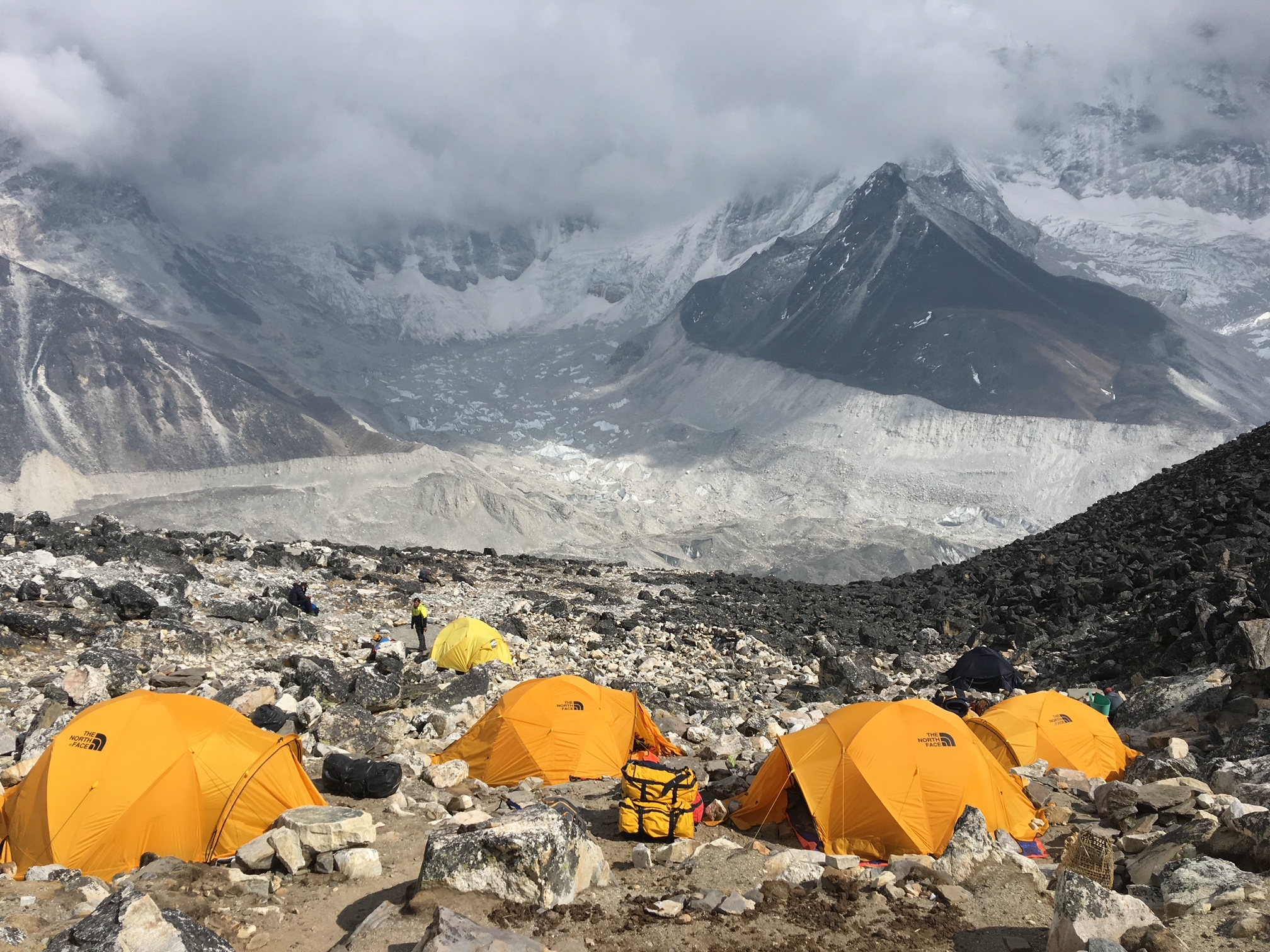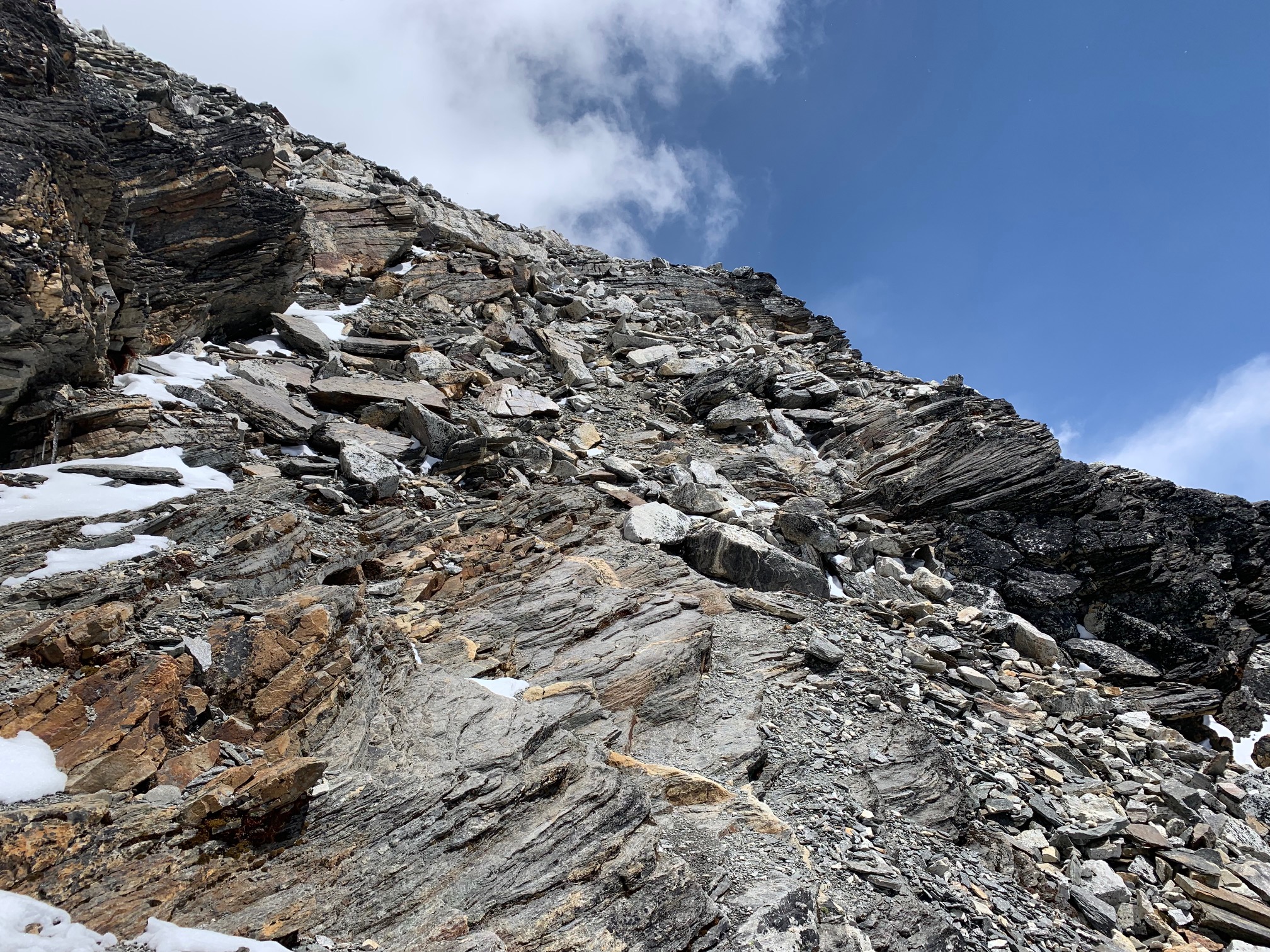Any peak that requires months of preparation, should require months of research. Our trips may not be for you. We are aiming at people who want to learn more about mountaineering, give themselves more safety, more staff with better support and acclimatization. Check out our unique itinerary.
Becoming More Self-Sufficient
Firstly, our goal is to educate, develop and ensure the highest safety and give the best chance at the summit. Secondly, we have a maximize group size of 8 climbers with western guide and highly experienced Sherpa Team running back-to-back trips managing our consistency and safety. After trekking to Everest Base Camp and Kala Patthar 18,520 feet the team will return to Chuckung 15,419 and start preparation for Island Peak. Finally, we will conduct ladder training and refresh your knowledge on jumaring, rappelling using a figure of 8 and managing yourself on fixed lines. Read some reviews from our trips.
Island Peak Base Camp
Time to move to Island Peak Base Camp for two nights. We will aim to do an much training as possible and as much as needed. There is a chance to make sure all your gear is working correctly. Practice putting on your crampons 20 times and practice with your gloves on. The more relaxed and comfortable you are with all the mountaineering equipment the better. Follow us on Instagram.
Island Peak High Camp
From here we move to Island Peak High Camp 5,500m/ 18,044 feet for our summit attempts. We also have highly qualified guides and western guides on all these trips. We fix our own ropes on the head wall and have cooks and support staff carry gear to crampon point to give the best safety on our trips. You will hear people tell you there is no water at high camp. This is not true, right over the ridge is plenty of water coming off the glacier. The challenge is you need a team of support staff to go get it. Our goal is to reach High Camp around 2pm. Twelve hours before we take off on our summit night.
Gearing up for Summit Night
I will wear different layers depending on the month I am climbing. March will be colder than May. November will be colder than September. If you need to consider which month you plan on climbing and adjust your gear accordingly. Watch our packing video. I always use my double mountaineering boots on with my thicker mountaineering sock on Island Peak. 260 merino base layer with Gore-Tex shell in colder months. Sometimes I use an insulted layer or trekking pants. Work with 4 layers on top with Gore-Tex shell, you can mix and mash layers as needed. We recommend having liner gloves, bigger gloves, and work gloves for the headwall and rope work. Make surre you have a light hat that fits under my helmet, with polar buff to cover my mouth. We send you itemized kit list on signing up.
We will wake up at 12:30am and start drinking water. I usually like to drink a couple of liters before I leave. At 1am our staff will bring a light breakfast with tea or coffee. Around 1:30am or just before we leave our staff will help with filling up your Nalgene bottle or bottles with boiling water. I always carry 2 liters of water with me on the summit night. The route is steep out of camp as we move across mixed rocky terrain in bulky mountaineering boots.
The Scramble
The guides will lead the way in the dark and it takes about 30 minutes of walking before we start zig zagging starts and the route gets steeper. There are several sections where you need to scramble, and you will need to use your hands to climb. There are lots of steep step ups, and steep rocky terrain as you make your way up through the gullies on Island Peak. We will hike for an hour, then take and break. We will continue in this format all the way to the glacier and crampon point.
The Grey Rock
After we have made our way through the gullies, we cross some exposed sections although hard to see in the dark. You need to maintain your balance and maintain 3 points of contact in some places. We move across Island Peak to the climbers right and start a steep ascent all the way up to the traverse to crampon point. This section needs mental focus as move across steep terrain for about 45 minutes. You just need to get your breathing right and take one step at a time.
The Traverse
The traverse to crampon point is a short, exposed rocky ridge with some fixed lines in place. I will usually have my harness; on I can clip into the fixed line for added safety. You need to make sure you have good foot placement, holding onto the rocks as you move across this ridge. You should stay on the left side of the ridge on the way up to crampon point.
Crampon Point
After about 2 and a half to 3 hours of hiking you will reach crampon point. The speed will depend on the itinerary and acclimatization. Once you are crampon point is may be cold, so being efficient with your time is important. Make sure your harness is tied correctly, get your crampons on as quickly as possible and stay warm. You will also need your ice axe for the next section of the climb. The guides will get ropes out and start getting each team member roped up.
Moving onto the Glacier
We will move onto the glacier in small groups. There may be a need to come off the rope and used fixed lines and this will be managed at the time. We will use fixed lines and additional safety line for ladder crossings. Once we move through the undulating glacier on Island Peak, it becomes more gradual as we cross the football field to the base of the head wall. The terrain gradually gets steeper and steeper. We will move to the base of the fixed lines and take a 15/20 minute break. This is weather dependent. We will eat and drink water and prepare our gear for the final section to the summit.
The Headwall
The Sherpa guides will be moving ahead fixing our own ropes. We may fix our own route to the summit. This will depend on the amount of people on the mountain. We will need to be fast getting back down so having our own rope helps us move more efficiently on the head wall. This process can take time, after a short break we will start moving up the fixed lines.
You will clip into our rope with your safety line and place your Jumar below the carabiner. As the terrain gets steeper, I recommend 3 movements and then stop for recovery. You need to be in control of your breathing and movement all the way to the summit. You will come up on some anchor points and it is important to move your safely line with carabiner first. Leave your jumar in place while to keep your balance.
Only when you have the safety line safely above the anchor can you remove your jumar and place It above the anchor point. Keep moving upward to the next section of rope. It can take an hour to one hour thirty minutes to reach the summit from the base of the headwall. You need patience for this part of the climb. You need to be fully aware of your surroundings as move slowly towards the summit.
Getting Back Down
Getting to the summit is only halfway. Most accidents happen on the way back down. It is time to focus on getting back down quickly and safely. We will abseil or rappel each section of the headwall and then wait at the bottom of the head wall in a safe place. Rappelling using a figure of 8 is straight forward but lots of practice is needed to be efficient so all our team members can get back down in a timely manner.
Retracing Your Steps
The other benefit of high camp is that we have an established camp with backup staff and resources if needed. Once we return to high camp, we usually pack up our gear and move to Chuckung. If we are late in the day, we have the option of returning to Island Peak Base Camp for the night. It takes one hour to make our way back down to Island Peak Base Camp and further 2 hours to hike back to Chuckung.
Contact the Island Peak Experts
Finally, we have led hundreds of people to the summit of Island peak over the last 15 years. All our Sherpa staff work directly for us and run back to back trips to Island Peak to maintain safety and consistency. I have personally developed our itinerary and led 19 Expeditions to Island Peak and happy to answer any questions you may have. Feel free to email me today and set up a time to chat. Learn more important information about Island Peak.














